#racial segregation
Text

The murder of a child is every parent’s worst nightmare, but what if you’re then wrongly accused of that child’s murder? That is the very nightmare that befell James Joseph Richardson, who was wrongly convicted of the murder of seven of his children.
On 25 October, 1967, Richardson left his seven children, ranging from two-years-old to eight-years-old, in the care of his neighbour, Bessie Reece, as he and his wife, Annie Mae Richardson, went to work for the day. Progressively throughout the day, each child became violently ill. By the next morning, all of the children would be dead. An autopsy revealed that all of the children had been poisoned.
An initial search of the Richardson apartment revealed no poison. However, the following day, a bag of parathion was discovered in the shed behind the apartment. It was noted that it wasn't there the day beforehand. Despite the fact that Richardson was a caring and loving father and that there was no reason for him to kill his children, he was arrested and charged with their murders.
Cellmates of Richardson claimed that he had confessed to murdering his children and during a time when racial segregation was high, an all-white jury found this evidence enough to convict him, completely disregarding the fact that the children were fed by Reece, not Richardson. He was sentenced to death.
Richardson remained incarcerated for twenty years. Mark Lane, a well-known trial attorney, decided to take matters into his own hands and began to look into the case. It was revealed that Reece had been out on parole at the time of the murders. What for? She murdered her husband with poison.
At the time Reece was living with caretakers as she was suffering from Alzheimer’s. She had confessed to the murder of the Richarson children 100+ times to these caretakers. It was also revealed that the cellmates of Richardson had lied about his confession in return for a lighter sentence.
Richardson was eventually released in 1989 and filed a lawsuit for his wrongful incarceration, getting just $150,000. Eventually, in 2014, bill HB 227 was signed into law, meaning that wrongfully incarcerated inmates can be granted compensation for time served. It was estimated that Richardson could be awarded up to $1.3 million, however he hasn’t yet received that compensation.
78 notes
·
View notes
Text


for reference: the title of this post is a reference to the extremely discriminatory signs that were in front of stores during racial segregation:
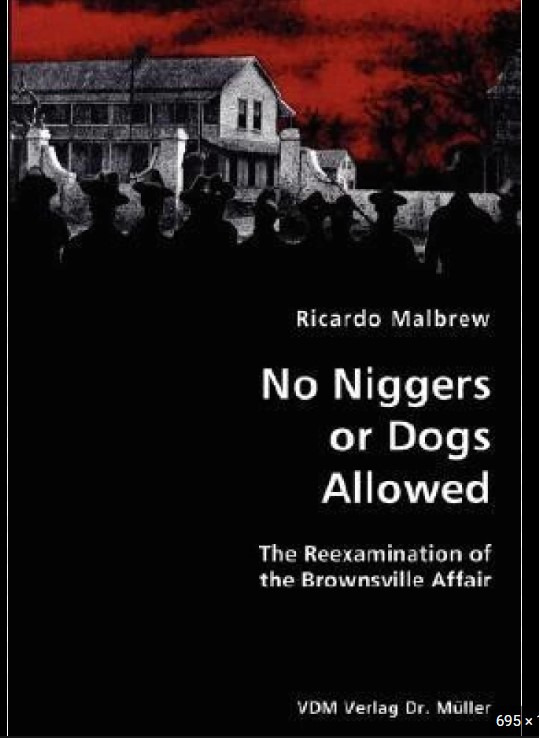

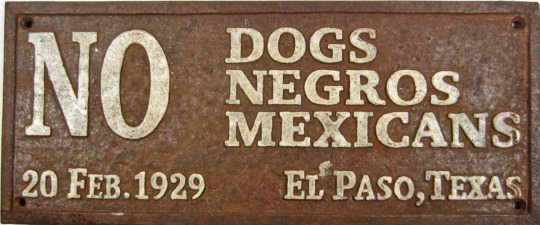

imagine being so privileged that you compare people not wanting men in their spaces to literal apartheid and racial segregation.

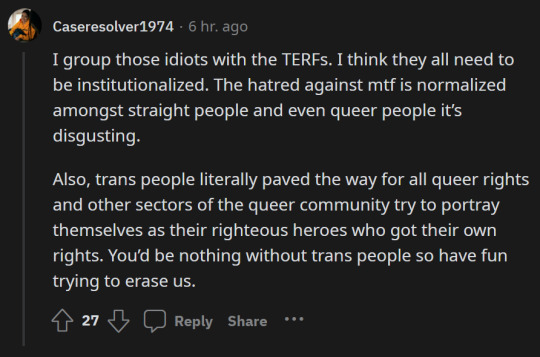
"they all need to be institutionalized" oh my god


probably because you behave exactly like a cis man and these people are able to pick up on that
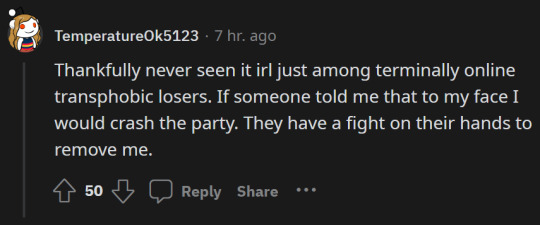
"I really hate it when people assume that just because I am male, I am violent. That's why when someone tells me that I can't go somewhere, I am going to FUCKING BEAT THAT PERSON UP!"
#radical feminism#radblr#radical feminists do interact#radical feminists please touch#gender critical#terfblr#gender critical feminism#gender critical safe#trans cult#gender abolition#male socialization#socialized as a male#radfem safe#female only spaces#racial segregation#jim crow#apartheid#transfem
179 notes
·
View notes
Text
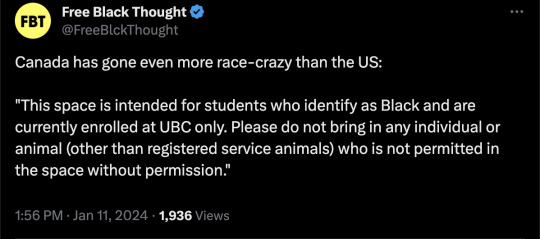

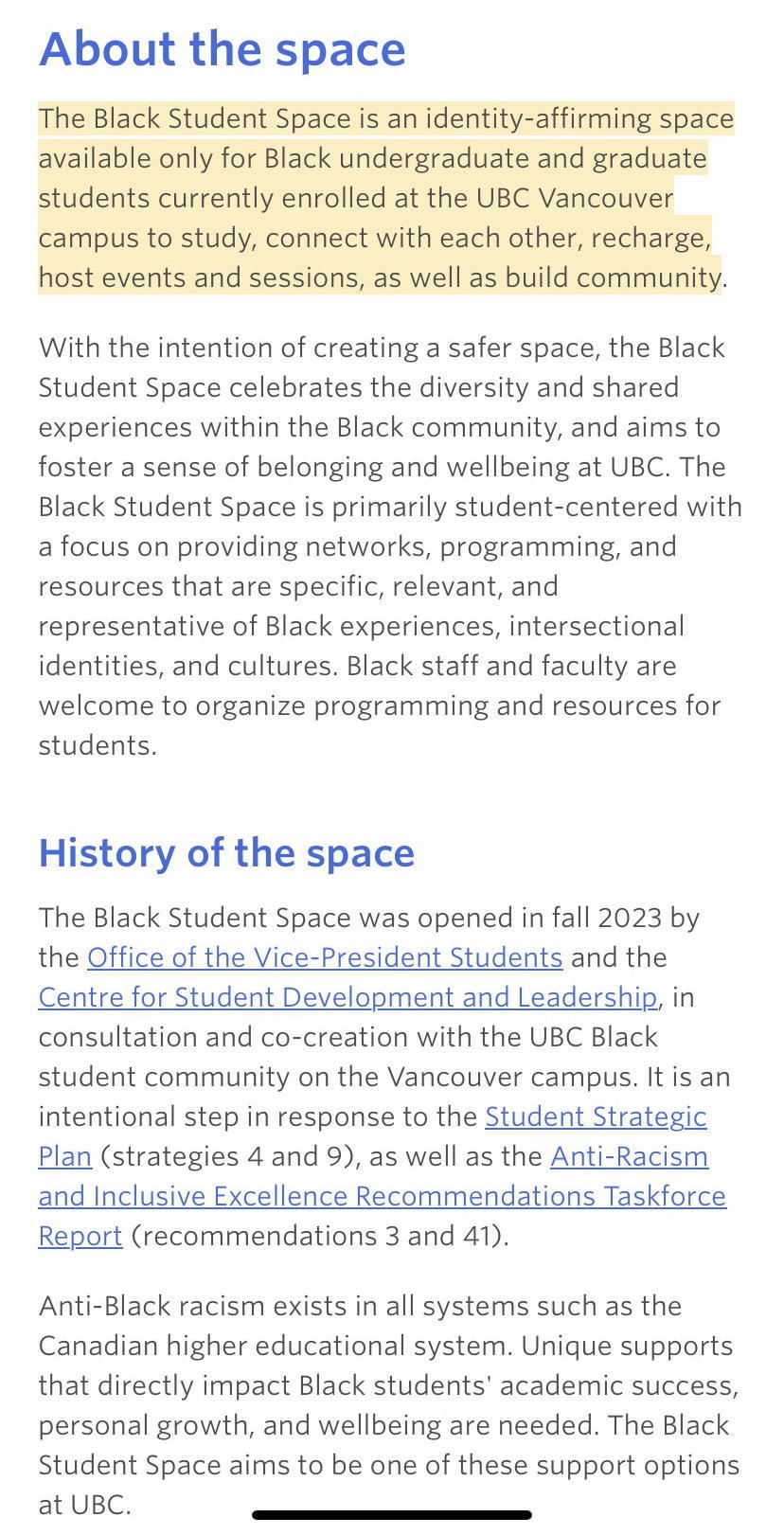

[ Archived snapshot: https://archive.md/9EclE ]

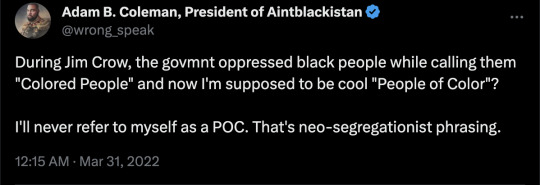

==
People are surprisingly proud of the return of segregation.
#Free Black Thought#Jonathan Kay#segregation#identify as#i identify as#racial segregation#University of British Columbia#race crazy#antiracism#antiracism as religion#religion is a mental illness
22 notes
·
View notes
Text
71 notes
·
View notes
Text

youtube
#George McLaurin#racial segregation#oklahoma#tulsa#brown v board#14th amendment#scotus#univ of oklahoma#seperate but unequal#Youtube
19 notes
·
View notes
Photo

"African American high school girl being educated via television during the period that the Little Rock (Arkansas) schools were closed to avoid integration." Photographed September 1958 by Thomas J. O'Halloran.
77 notes
·
View notes
Text
I'm kind of pissed at how few people are even talking about the fact that race based affirmative action policies were struck down in the US only two days ago. I'm kind of pissed at how few people are even talking about the fact that SCOTUS is now arguing in favor of legacy admissions, which literally existed to limit the number of POC able to be admitted into colleges/universities per year. SCOTUS wants to pretend to make college admissions "not see color," while upholding white supremacist systems that will make it much easier to discriminate against POC and much easier to favor white people when admitting students.
They're basically trying to fully reinstate segregation at this point with their promotion of Jim Crow relics and I haven't seen a single white person fucking talking about it.
#i'm not american but it's so scary watching poc get targeted and nobody giving a fuck#it's SO fucking frustrating that white people don't care because it doesn't affect them#and i hate to say it but if this was another anti-queer law y'all would be all over it#but none of that energy is there bc it's racism instead#human rights#racism#racism tw#supreme court#scotus#racial segregation
12 notes
·
View notes
Video
youtube
How Black and White Southern Timber Workers Almost Smashed Capitalism by NonCompete
#thought provoking#evils of capitalism#unionization#racism#racial discrimination#racial segregation#355/365
4 notes
·
View notes
Text

"The third, and equally critical component of the new penological disciplinary regime at Sing Sing was the development of techniques aimed at the discovery, classification, and eradication of sexual relations among prisoners. Sex had almost certainly been going on in prisons since the first prison was built. But the opportunity for sex had probably been much more restricted in the hard-labor prisons of the nineteenth century; and when hard industrial labor collapsed in many American prisons, as the contract system was dismantled, opportunities (and perhaps prisoners’ energy) for sex were greatly multiplied. Prison administrators of the early twentieth century appear to have known that prisoners were having sexual relations with one another. Nonetheless the subject was not openly discussed or theorized in any sustained manner.
This began to change in the 1910s. From the point of view of a penology committed to the socialization of prisoners as self-governing manly citizens, sexual relations between men posed a particularly urgent problem. Through the lens of the prevailing gender ideology of early twentieth century ... sex between men was intrinsically emasculating of at least one partner – the supposedly passive “receiver,” whether or not the sex was consensual. Such a feminized position, as it were, contradicted precisely the ideal of manly subjectivity that the new penologists sought to realize in prisoners. Added to this difficulty was the problem of “manly discipline”: The new penologists hued to an ascending, middle-class view that, rather than reflexively act on their sexual passions, men ought to channel or sublimate those passions into activities deemed socially or personally useful. On this view, then, the active or penetrative partner, although supposedly the masculine partner in the act, was failing to exercise manly self-discipline; he, too, presented a challenge to the manly ideal. In their Sing Sing laboratory, Osborne and his fellow penologists proceeded to drag prison sexuality into the light of day, examine it, and “cure” it.
Fragments of evidence from the New York prison records of the early 1910s suggest that sex among prisoners at Sing Sing and elsewhere had been happening for some years. In some instances, it involved physical coercion, but in many it did not. As James White’s report had suggested, sex was being traded for food or money as a matter of course. Various reports also suggested that, before Osborne arrived at Sing Sing, such relations mostly went unpunished, and that when a person was punished in connection with prison sex, it was usually in connection with a sexual attack. It was not the aggressor, however, who received the punishment: Any prisoner who complained to the warden that he had been coerced into sex, and any prisoner who sought protection from coerced sex, was likely to be severely disciplined, while the alleged attacker – or attackers – would probably not be disciplined at all. (One of Osborne’s predecessors at Sing Sing, Warden John Kennedy, had sometimes gone so far as to send the complainant, rather than the alleged attacker, to New York’s most feared prison – Clinton). Similarly, when Superintendent Riley heard of cases of sexual assault occurring during Osborne’s wardenship, he proceeded to order the transfer of the complainants to Clinton, which suggests that the punishment of the complainant was standard practice. Indeed, it is likely that the act of complaining, and not the act of sodomy per se, was cause for punishment in prisons of the 1900s and early 1910s.
Osborne and the new penologists broke with the usual approach to prison sex, and on a number of counts. First and most conspicuously, Osborne discoursed at some length – and in public – on what had thitherto been the taboo topic of sex in prison; in true progressive style, Osborne argued that in order to solve the problem, one had first to study and understand it. Describing sex between convicts as “vile” and as a “problem ... which should no longer be ignored,” Osborne made it clear that he considered sex between men to be one of the most serious and little-understood problems of the American prison. In his early speeches and writings on the topic, Osborne drew distinctions between different kinds of men who engaged in sex with other men. On the one hand, he explained to members of the National Committee on Prisons and Prison Labor (NCPPL), there was the man who “allows himself to be [sexually] used”; on the other, there was the man whose “passions are cut off from natural relief.” The latter, according to Osborne, was simply acting on an “ordinary” sexual impulse that, because of the deprived conditions of incarceration, had been directed toward a man, rather than a woman. As Osborne wrote in Prisons and Commonsense, “Here is a group of men – mostly young and by no means deficient in the natural passions of youth – but cut off from the natural means of satisfying them.” Osborne refined this rather crude typology a few years later, in a tripartite taxonomy recalling Sigmund Freud’s 1909 classification of inverts in Three Essays on the Theory of Sexuality: According to Osborne, in prisons one found the “degenerate,” whose “dual nature” made him the passive (and therefore feminine) partner of active, masculine men; the “wolves,” a popular term that Osborne appropriated to describe aggressive men who consistently preferred men to women; and the “ordinary men,” whose incarceration deprived them of their “natural” sex outlet – sex with women – and who consequently made use of other prisoners as “the only outlet” they could get.
Finding ways to channel the natural passions of “ordinary” men and youths turned out to be one of Osborne’s key projects at Sing Sing: Indeed it was a recurring theme of his wardenship. Osborne developed several tactics in his fight against the “vile” practice: He emptied the cellblock of the surplus of prisoners (whom he installed in a dormitory), so as to ensure that there was only one man per cell; he attempted to direct the natural passions of the supposedly ordinary men to nonsexual activities; he implored the Mutual Welfare League to police prisoners’ sexuality and to “condemn vice and encourage a manly mastery of the passions;” he set about identifying and isolating both the “degenerate” men who offered themselves as passive partners and the “wolves” who actively preferred other men; and he redoubled his efforts to smash the underground economy that James White had identified as a principal stimulant of prisoners’ sexual relations. (According to White, the systematic theft and underdelivery of prison provisions led to hunger among the prisoners, who then sold sexual favors for cash, and used the cash to buy the stolen food on the prison’s black market).
This latter tactic was especially crucial in Osborne’s strategy. As Osborne put it, every prison had “some degenerate creatures who are willing to sell themselves, any time, for a few groceries,” and the key to the prison sex problem in general was to ensure that prisoners were, on the one hand, well fed (and therefore not in need of procuring cash for extra food), and, on the other, afforded appropriate mental, physical, and spiritual outlets for their natural passions. In theory, the reconstitution of every prisoner as a waged consumer and producer in a simulated economy would ensure that the prisoner was no longer in a position of emasculating dependence. As long as convicts were eating well, engaging in a market economy that rewarded hard work and promoted financial responsibility, and sublimating their life force in educational and recreational activities, Osborne reasoned, the sex market in prisons would lose both its buyers and sellers.
Osborne’s conceptualization of the prison sex problem underscored the new penology’s central commitment to innovating various disciplinary activities that would absorb and direct prisoners’ energies in the face of limited industrial and other forms of labor. As the new penologists saw it, plays, motion pictures, lectures, musical events, and athletics not only addressed the problem of underemployment and initiated prisoners into the personality-building pasttimes of the ideal citizen, they sublimated the libidinal drive of the ordinary convict. Indeed, Osborne established a number of new activities at the prison in the name of vanquishing the “unnatural vice” that the prison investigators had documented in the early 1910s. Prisoners converted a basin in the Hudson River into a large swimming pool in 1915, because, as Osborne put it, swimming was a “practical method of reducing immorality” and an activity in which prisoners would “work off their superfluous energies. ... and head off unnatural vice.” (Four hundred prisoners per day were working off their “superfluous energies” in the pool by 1916). One of Osborne’s support committees, The New York State Prison Council, reiterated this point in defending the innovation of moving pictures, lectures, concerts, and other stimulating activities at Sing Sing. “These were established not as Amusements;” the Council explained somewhat defensively, “but as a definite means to an End” (caps in original): That end was “keeping the men out of vermin-ridden cells and of stimulating their minds – inured to the gray and sodden monotony of Prison walls.”
It was in no small part to combat prison sex that Osborne and the new penologists paved the way for the introduction of psychiatric and psychological testing to Sing Sing in 1916. Osborne and his supporters considered psychomedical study a crucial tool in their efforts to more accurately classify prisoners and to develop a specialized state prison system; to the classificatory system that administrators had established in the 1890s (and which classified and distributed convicts according to sex, age, sanity, physical fitness, and supposed capacity for reform), the new penologists added the distinctly psychological categories of sexuality and personality. In their view, sexual “degenerates” were a distinct category of prisoner and the prison system ought to identify and deal with them separately. Whereas the new recreational activities, better food, and prisoner self-policing were aimed at eradicating the sexual relations of the supposedly ordinary prisoner, the small army of doctors, psychiatrists, and psychologists who descended on Sing Sing in 1915 and 1916 were chiefly concerned with the group of prisoners Osborne had described as degenerate.
The new penologists’ effort to conscript psychiatry and psychology into prison reform was complemented by the reformers’ enhancement of general medical facilities at Sing Sing in 1915 and 1916. In February 1915, the New York State Department of Health inspected Sing Sing and recommended that a separate ward be set up for patients suffering from sexually transmitted disease (STD). This recommendation was seconded a few months later by two state investigators who suggested that Sing Sing open a new hospital in which “psychopaths,” STD patients, and convicts suffering from contagious diseases would be held separately from prisoners in the general wards. Those suffering from infectious diseases other than STDs would be labeled “normal,” while “psychopaths” and STD patients should be held in a ward for “special” cases. The investigators further recommended that a psychiatric study of prisoners be undertaken in which all new admissions to the prison would be thoroughly studied according to a case method, with special attention paid to those with mental and nervous disorders, “sexual perversions,” suicidal tendencies, and records of multiple convictions. The 1915 plans for a psychomedical facility at Sing Sing proposed a double innovation of the established prison system: The psychic lives of prisoners would be added to the fields of scrutiny, and the past and present sexual practices (and desires) of convicts would be read as signs of a peculiar psychic type (the psychopath), who, in turn, would be incarcerated in separate facilities.
The following year at Sing Sing, Dr. Thomas W. Salmon, of the National Committee for Mental Hygiene, and Dr. Bernard Glueck, a psychiatrist who had recently instituted nonverbal intelligence testing of immigrants at Ellis Island, set up the country’s first penal psychiatric clinic. Funded by a sizable grant from the Rockefeller Foundation, the clinic proceeded under Dr. Glueck’s directorship to examine virtually all of the 683 prisoners committed to Sing Sing between August 1916 and April 1917. Glueck’s dense, seventy-page report on his findings was published to much acclaim in 1917; it was the first comprehensive psychiatric case study of adult convicts in the United States. Like the Health Department investigators, Glueck conceived of his studies as just one element in the much larger effort to develop “rational administration” in imprisonment. He and his clinicians proceeded to interview every incoming convict about his family background, sexual practices, health, education, and employment history; they then conducted a series of psychological tests for “mental age” and dexterity, and administered psychiatric tests of the prisoner’s emotional state. On the basis of this information Glueck divided all the incoming prisoners into three groups: the intellectually defective (those with low “mental ages”); the mentally diseased (those who suffered from hallucinations and delusions); and the psychopathic, whom he described as the most difficult to define and the most baffling. He concluded that almost six out of every ten of the incoming convicts were either intellectually defective, mentally diseased, or psychopathic.
Glueck’s study of Sing Sing convicts was one of the first to theorize the existence of “psychopath criminals,” and his work became foundational both in studies of criminality and homosexuality. According to Glueck, approximately one in five of the incoming prisoners was a psychopath. It was to this category that those prisoners with a history of homosexual relations were most commonly consigned. As Glueck put it, the classification of psychopathic was a judgment of the prisoner’s entire way of life, not just the crime he had committed; sexual habits were one of four determining fields of enquiry (the others were the family’s medical history and the convict’s employment and education history). From the beginning, then, scrutiny of prisoners’ sexual relations – and homosexual relations in particular – was critical in the study of psychopathology among prisoners. He wrote that, “in contemplating the life histories of these (native-born psychopaths), one is struck very forcibly with the unusual lack of all conception of sex morality.” A wide range of sexual activities, and not simply sex between men, was read as psychopathological. He described one in three psychopathic prisoners to be “markedly promiscuous,” and nine percent as polymorphously perverse: He was perplexed to find that many individuals who had had “repeated” sexual relations with other men had been equally sexually active with women, and concluded simply that these convicts were not “biologically sexually inverted.” They were, however, as psychopathological as “biological inverts.”
....
As well as striving to discover, prevent, and punish sexual relations between convicts in the model progressive prison, the new penologists attempted to change relations between black prisoners and white prisoners. Unlike the matter of sex, neither the “race question” nor the prison’s small minority of black prisoners were objects of sustained discourse among Sing Sing’s reformers at this time. Nonetheless, race ideology deeply influenced and was, in turn, influenced by, the new penological program of reform. At Sing Sing (and at Auburn) the new penologists set about classifying and more formally segregating prisoners on the basis of the “one-drop” criterion of American race ideology. The new penologists conceived of their task primarily as one of assimilating prisoners born in Europe and native-born Americans classified as “white” to an ideal, manly citizenship. Programs that were designed to socialize prisoners as citizens were implicitly aimed at white native-born Americans and European immigrants; certainly, no resources were specifically earmarked for the education or postrelease employment of black prisoners. Many of the educational programs were specifically aimed at Italian, Polish, and German immigrants, with the objective of socializing them to be good Americans. Classes were started in English literacy and civics (the one at Auburn was known as the “Americanization” class) for white prisoners, and on at least one occasion, a large business enterprise sent an Italian-speaking agent to Sing Sing to train and recruit Italian convicts for postrelease employment. Besides crafting a prison program that took for granted that white convicts were the proper object of reform, the new penologists took steps to formalize and rigorously enforce the physical separation of white from black prisoners. Black prisoners were concentrated in the unskilled work companies, and white prisoners in the semi- and skilledlabor companies by day. By night, under Osborne’s direct orders, black convicts were segregated from white convicts. Early on in his wardenship, Osborne’s expressly prohibited white and black convicts to share cells with each other.
Black prisoners did not miss out entirely on the privileges and activities established under the new penologists. As a rule, privileges that were extended to white prisoners (such as membership in the leagues, participation in sports, etc.) were generally extended to black prisoners, too, suggesting that the new penologists considered black prisoners capable of participating in democracy and civil society. But, as had been the case at Auburn, these privileges were always extended in such a way that they would not undermine the segregation of white from black, nor, more critically, raise a black prisoner above a white prisoner. Indeed, new penological reform in general seems to have formalized race segregation and, not incidentally, widened racial inequality, at Sing Sing.
- Rebecca M. McLennan, The Crisis of Imprisonment: Protest, Politics, and the Making of the American Penal State, 1776-1941. Cambridge University Press, 2008. McCormick, p. 397-402, 404.
Image is Warden T. M. Osborne, Sing Sing, centre, surrounded by Sing Sing prisoners. c. 1915-1916. Bain News Service glass negative. Library of Congress. LC-B2- 3310-7.
#sing sing prison#penal reform#progressive penology#thomas mott osborne#prison discipline#penal reformers#prison administration#crisis of imprisonment#new york prisons#classification and segregation#wolves and punks#history of homosexuality#history of heteronormativity#sex in prison#racism in america#african americans#racial segregation#history of crime and punishment#academic quote#reading 2023#psychiatric examination#psychiatric power#prison psychiatry#criminal psyc#criminal psychology
3 notes
·
View notes
Text
Facing History
Outside, baptisms, weddings and funerals I haven't attended church my entire adult life. I haven't lived in the South since I was 16. Nevertheless both the Episcopal Church and the South are part of my identity.
Recently I dove head first down a rabbit hole on the subject of John Henry Hopkins: ironmonger, musician, lawyer, theologian, architect and the eighth Presiding Bishop of the Episcopal Church. He was an important figure in local Pittsburgh history, which I hadn't known before. There were many connections to make which had me clicking from article to article. And then I landed on an article by Woody Register, In Their Own Words: An introduction John Henry Hopkins--first Bishop of Vermont, artist and architect, and defender of slavery, which put a damper on the hagiography of Hopkins emerging in my brain.
The article was in Meridiana: The Blog of the Roberson Project on Slavery, Race, and Reconciliation at Sewanee. Many of the most influential people in my young life had attended Sewanee:The University of the South. My attention shifted from john Henry Hopkins to The Roberson Project.
"The Roberson Project on Slavery, Race and Reconciliation at the University of the South is a six-year initiative investigating the university's historical entanglements with slavery and slavery's legacy."
I spend way too much time at Youtube and it seems that I can't view a video without viewing a commercial for Hillsdale College. I wonder if that's because Google's algorithm "knows" those commercials particularly aggravate me--high engagement--or whether every American must see those damnable commercials? Anyhow Hillsdale's 1776 Curriculum (paywall at NY Review of Books. This article at Brown Political Review is open.) is in sharp contrast to Sewanne's approach to history. What's especially important about the differences is the view of the present and towards the future.
Emptywheel is a favorite blog. On the weekends Ed Walker writes posts that are a bit like a book discussion forum. Recently he did a series on the reconstruction era. In the last post in that series he noted that in his education as a young person that he had " no memory of any of the history I’ve discussed in this series." There's a concerted effort to ensure that students today be ignorant about our history of legally enforced and violently imposed racial segregation. A rational for much of the current "anti-woke" legislation is to save white children from discomfort. I was struck by the anger Walker felt in uncovering the history. Surely some students today will be enraged discovering what was hidden from them in school.
The Civil Rights Movement forced a paradigm change about race. And the struggle continues. Hiding that knowledge from children is madness.
Blundering around Sewanee's Website I read a profile of the first Black graduate of the College of Arts & Sciences, Nathaniel “Bubba” Owens, class of 1970. In 1966 the year Owens enrolled, the Episcopal school I attended had to confront how to respond to segregation.The school decided to enroll Black student beginning in kindergarten. A decision that seems "weak sauce" but is more significant when taking into account the proliferation of "Christian" schools in the South in response to court-ordered school desegregation. There were close associations between my school and Sewanee. I'm pretty confident the Black football player at Sewanee was known to some of the folks trying to forge a path for my old school.
The Robeson Project is named for Houston Roberson the first African American to earn tenure at the University of the South. Robertson died too young and was clearly well regarded at the University. But the naming the project for him points to a fundamental change in perspective. In 2009 he wrote an essay for the University's sesquicentennial volume.
"Dr. Roberson sought to show that African Americans, race, and racial conflict were “not a ‘Negro’ problem but an American problem.” Likewise, the history of slavery and its legacies at the University of the South is “not a ‘Negro’ problem,” but a Sewanee problem."
White Americans facing this country's history is something to celebrate. Not in a "that's mighty white" sense of goodness and righteousness. But in the more practical sense that the possibility of reconciliation and justice require a foundation of truth.
#southern culture#american history#education#law#the university of the south#racial segregation#white supremacy
3 notes
·
View notes
Text

#beach#strand#society#Gesellschaft#black#white#people#human#rassentrennung#past#Vergangenheit#racial#racial segregation#afrika#africa#south africa#zuidafrica#history#Geschichte
10 notes
·
View notes
Text

This is something that happened TODAY.
Today. in 2022.
A sitting senator called for reversing the decisions to end racial segregation.
5 notes
·
View notes
Text
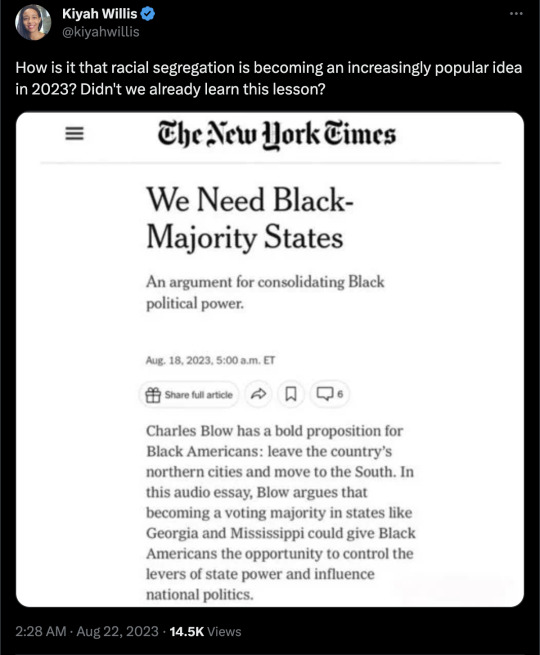

"How is it that segregation is becoming more and more popular in 2023?
A New York Times article is calling for black people to move to the south to create black majority states. The reason? They believe it will give black people more power to influence politics.
Now, who wants to break the news to them that putting a bunch of people together with the same skin color doesn't mean they're all going to agree on the same policies?
Contrary to popular belief, not all black people think the same, like I'm disagreeing with this writer about creating black ethno-states.
I'm sure he would rather have a white person, an Asian person, a Hispanic person, or really anyone who agrees with his political views over someone like me living in his state.
It's just unfortunate that after all of this time and all of this progress that we have made towards a colorblind society, some people just refuse to see past skin color."
The headline was subsequently changed to "Dear Black Americans, Please Move to the South."

"All the black people should be kept over here, away from white people" is an amazing position to be cheering on under the banner of progress.

youtube
[ Play: IKEA or Death ]
#Kiyah Willis#Angel Eduardo#antiracism#segregation#racial segregation#antiracism as religion#neoracism#ethno state#religion is a mental illness
25 notes
·
View notes
Text
#talkin#tik tok#theconsciouslee#public schools#busing#racial segregation#segregation#schooling#racism#white flight#education reform#education
71 notes
·
View notes
Link
4 notes
·
View notes
Photo

The 1965 White Citizens’ Councils had a lot of nerve creating this cottage industry of private schools to keep their white children from non-white children.
Do their arguments sound any different than the Voucher Crowd?
#Bob Jones University#Archive#BJU#Klandamentalism#1965#White Citizen's Councils#racial segregation#private school#Segregation academies#White Citizens' Councils
2 notes
·
View notes